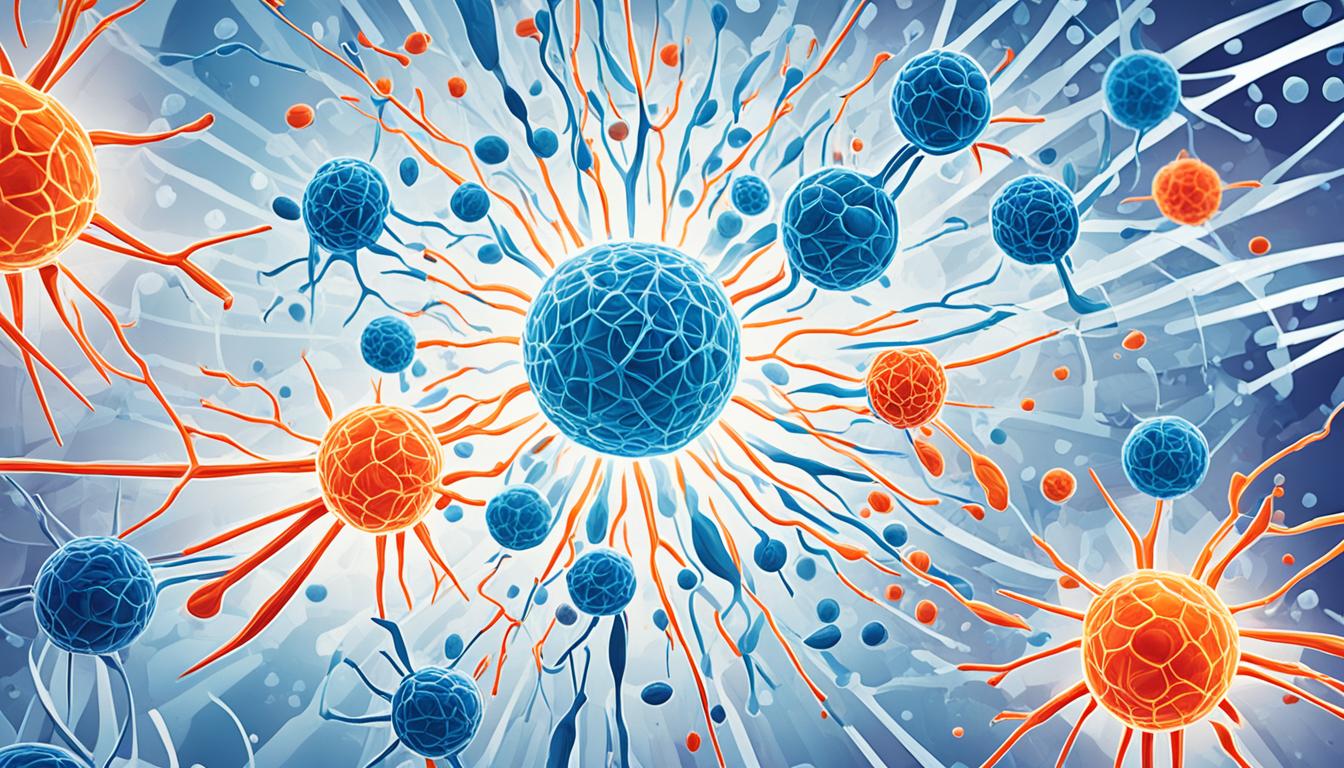Non-Hodgkin’s lymphoma is a cancer that starts in the lymphatic system. This system is key to our immune system’s work. The disease makes lymphocytes, a kind of white blood cell, grow out of control. They can then build tumors in different parts of the body. The exact causes are still not completely known. Yet, we do know some things that can increase the risk. These include a weakened immune system and certain infections.
The disease shows itself in a few ways. Some common signs are swollen lymph nodes, pain or a bigger stomach, feeling very tired, having a fever, and losing weight without trying. If doctors suspect non-Hodgkin’s lymphoma, they start by taking a sample from a swollen lymph node. They then do more tests to see how severe the cancer is.
Today, there are several ways to treat non-Hodgkin’s lymphoma. These include chemotherapy, radiation, a stem cell transplant, and care to ease symptoms. Thanks to advances in understanding and treating this cancer, the outlook for patients has gotten much better.
Key Takeaways:
- Non-Hodgkin’s lymphoma is a cancer that impacts the lymphatic system and overgrows lymphocytes.
- Signs may show up as swollen lymph nodes, stomach pain, feeling worn out, having a fever, sweats, and losing weight fast.
- Diagnosing this cancer starts with a lymph node biopsy and more tests to check the cancer’s size and stage.
- Options for treatment include chemo, radiation, a stem cell procedure, and symptom-relief care.
- Progress in both diagnosing and treatment has boosted the chances for people with non-Hodgkin’s lymphoma.
Understanding Non-Hodgkin Lymphoma
Non-Hodgkin lymphoma is cancer that starts in the lymph system, part of the immune system. It grows from abnormal lymphocytes, either B cells or T cells. These cancers can make tumors in several body parts, like the lymph nodes, spleen, liver, stomach, and bones.
There are over 60 types of non-Hodgkin lymphoma. The most common are diffuse large B-cell lymphoma and follicular lymphoma. They differ in how quickly they grow and spread, affecting how someone with the disease feels. Knowing the subtype helps doctors choose the best treatment.
Non-Hodgkin lymphoma can impact both adults and children. The typical age at diagnosis is 68. It’s the sixth most frequent cancer in Australia, and cases rise with age.
Common Subtypes of Non-Hodgkin Lymphoma
| Subtype | Description |
|---|---|
| Diffuse large B-cell lymphoma | The most common subtype of non-Hodgkin lymphoma, characterized by rapidly growing tumors. |
| Follicular lymphoma | A slow-growing subtype that often remains indolent for many years. |
| Mantle cell lymphoma | A subtype that typically affects older individuals and can be challenging to treat. |
| Marginal zone lymphoma | A subtype that often arises in the mucosa-associated lymphoid tissue (MALT) and can occur in various organs. |
| Peripheral T-cell lymphoma | A group of subtypes that involve T cells and can have aggressive behavior. |
| Burkitt lymphoma | A rare and fast-growing subtype often linked with the Epstein-Barr virus. |
Symptoms, Causes, and Diagnosis of Non-Hodgkin Lymphoma
Non-Hodgkin lymphoma shows up with different symptoms. This depends on the type and how far the disease has spread. Signs you might notice include:
- Swollen lymph nodes in the neck, armpits, or groin
- Unexplained fever
- Excessive sweating, especially at night
- Unexplained weight loss
- Fatigue
The causes of non-Hodgkin lymphoma are not always clear. Yet, a few risk factors stand out. These include some viral and bacterial infections like HIV or Epstein-Barr, issues with the immune system, certain chemical exposures, and getting older.
To find out if someone has non-Hodgkin lymphoma, doctors do a biopsy. They take a small piece of the lymph node to check. After that, tests like blood work, imaging scans, and a bone marrow biopsy help show how far the cancer has spread.
Getting the right diagnosis and knowing the stage of the cancer is important. It helps doctors plan the best treatment for each patient.
| Common Symptoms of Non-Hodgkin Lymphoma | Causes and Risk Factors | Diagnostic Tests |
|---|---|---|
| – Swollen lymph nodes – Unexplained fever – Excessive sweating – Unexplained weight loss – Fatigue |
– Viral and bacterial infections – Immune system deficiencies – Exposure to specific chemicals – Older age |
– Biopsy of affected lymph nodes or tissue – Blood tests – Imaging scans – Bone marrow biopsy |
Treatment options and Prognosis
Non-Hodgkin lymphoma treatment choices depend on cancer type, stage, and the patient’s health. Options include chemotherapy, radiation, stem cell transplants, and palliative care.
Chemotherapy is a common choice for aggressive types. It uses drugs to kill or slow cancer cells’ growth. Radiation therapy targets cancer cells with high-energy beams, often used alone or with chemo.
For high-risk cases, a stem cell transplant might be advised. This is especially true if other treatments didn’t work well. Palliative care is key for those with advanced stages. It focuses on symptom relief and quality of life improvement.
The outlook for non-Hodgkin lymphoma varies, based on type, stage, and other personal factors. Yet, thanks to better diagnosis and treatment, many patients see improved results. Even if a cure isn’t possible, long-term control of the disease is often achievable. Regular doctor visits are vital for ongoing care.

